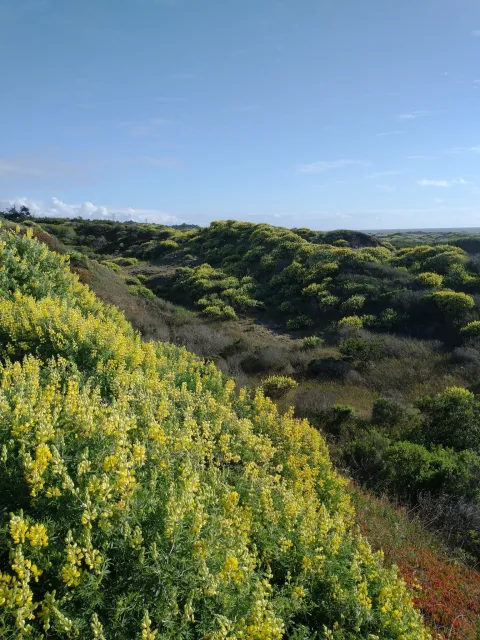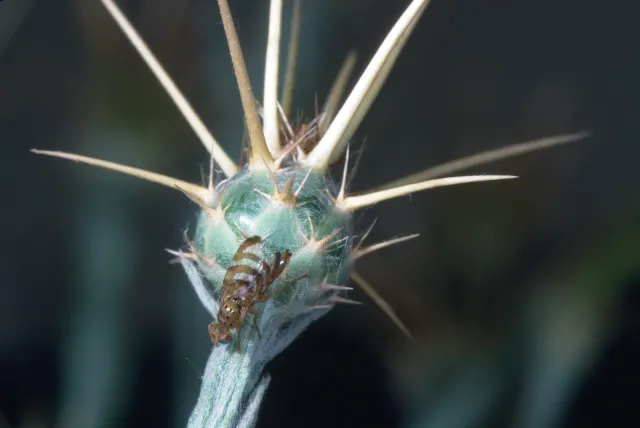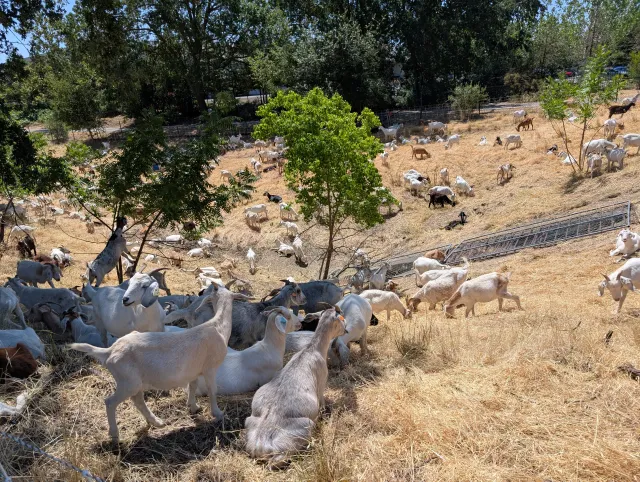UC IPM recently hosted a webinar about invasive plant management in California. During the presentation, our speakers Constance Taylor and Jutta Burger from the California Invasive Plant Council (Cal-IPC) answered live questions from attendees. Below are some of those questions and answers.
If you missed the webinar, you can watch a recording on our YouTube channel. This video provides an excellent overview of invasive plants in California, tools and resources for managing them, and actions you can take to help keep these plants from spreading.

Invasive Plants 101
Q: Can native plants be invasive if they are moved to different ecosystems within California, like from Southern California to Northern California?
A: It’s possible, yes, but not common. Yellow bush lupine (Lupinus arboreus) and Monterey pine (Pinus radiata) are two examples of plants that are native to areas within California but can become invasive when planted outside of their natural range.
Q: What is the difference, if any, between the terms noxious and invasive?
A: When it comes to weeds, the term “noxious” is typically used by regulatory lists, like California’s noxious weed list or the federal noxious weed list overseen by the United States Department of Agriculture (USDA). These are legal lists originally developed chiefly to protect agriculture. The USDA has the authority to designate plants as noxious weeds and control them through regulations. The term ‘invasive’ comes from ecology and lists like Cal-IPC's are not legally binding. There is significant overlap – many of the species on Cal-IPC's list are also considered noxious weeds by the state. The California Department of Food and Agriculture does manage a specific, legally defined, “noxious weed list” that is separate from its “A”, B”, “C”, and “D” pest ratings.
Cal-IPC’s Website and Other Online Resources
Q: Could you please share any resources that include a list of invasive plants specifically for the Central Valley?
A: You can go to our Inventory (https://www.cal-ipc.org/ ) and filter by the Central Valley Jepson region. If you are specifically interested in plants in horticulture, use that tab and filter by region. Check it out!
Q: How often are resources updated on the Cal-IPC website?
A: We regularly update plant listings and add new publications as they become available. The published documents are stand-alone and tend not to be updated once finalized.
Q: Are there resources like Cal-IPC’s website for invasive plants in other states?
A: Yes, many states have organizations like Cal-IPC and UC IPM! Most universities have extension programs that provide valuable information on invasive plant management, and there are many different independent (usually nonprofit) invasive plant-focused organizations in other states. (See the National Association of Invasive Plant Councils website). Other types of plant-focused organizations, like arboretums and land conservation groups, can also have invasive plant resources on their websites. At Cal-IPC, we do think that we have an especially robust set of resources available!
Q: Is there a database for natural enemies of invasive plants and weeds?
A: As showcased in the webinar, the WeedCUT online tool has some great information about biological control agents for a limited set of invasive plants https://weedcut.ipm.ucanr.edu/biological-control/. We are not aware of a comprehensive database available elsewhere. Many invasive plants don't have many natural enemies in their introduced range. They typically weren’t introduced with them and native natural enemies are not adapted to feed on them.

Invasive Plant Management
Q: Are nurseries being checked to see if they are selling invasive plants?
A: PlantRight (an organization that partners with retail nurseries to prevent the spread of invasive plants) is organizing a nursery survey for Spring 2026 to track whether any invasive plants (from a select list of 10-20 species) are still being sold. Many invasive plants are listed by the state on the CDFA noxious weeds list, and county Agricultural Commissioners’ offices are charged with nursery inspections to detect them. For other invasive plants that are not listed by the state, it is voluntary for nurseries to decide not to sell them.
Q: Is getting wood chips from an arborist a bad practice?
A: Sourcing weed-and-disease-free materials can be challenging. If you’re going to get wood chips from an arborist, make sure to get them locally so if any weeds or diseases are present, you’re not spreading them to a completely new area. Think of it as being similar in principle to the “Buy it where you burn it” campaign about not moving firewood, where they state as a very general rule that “50 miles is too far, and 10 miles or less is best.”
Q: Do goats used to control plants also spread invasive species?
A: It’s possible, yes, which is why timing of grazing is very important. Grazing should happen before seed set, and the timing can vary for different plant species as well as temperature and precipitation conditions. Timed grazing (whether by goats, cows, or sheep) is an important tool in invasive plant management. You can read more about grazing on the WeedCUT page here.
Q: Can you share resources for bindweed control?
A: See this UC IPM resource on bindweed control.
Q: Is anyone working with the California Department of Transportation (Caltrans) to manage invasive plants along roadsides?
A: Yes, many land management agencies coordinate with Caltrans on roadside vegetation management because roads are a significant vector for the spread of weeds. Roadside vegetation can also present a risk for wildfire ignition. For more information, see our publication on Prevention BMPs for Transportation and Utility Corridors. See also the Durable Ignition Reduction Toolbox, developed to assist agencies like USFS and Caltrans with roadside weed management in southern California. Lastly, Caltrans has recently updated its weed list and weed resources in an effort to better inform roadside weed work.
Q: Could you share any resources on timing chemical and non-chemical methods for controlling invasive plants? What are the best months or seasons to apply these methods?
A: The WeedCUT tool provides some information on timing. That information is in the “best management practices” text for each technique (just click on the technique). It might not be species-specific, but it is specific to the type of plant that you are treating (e.g., shrub, grass, etc. etc.)
Q: Where can I find information about managing well-established invasive trees and other woody weeds in my backyard?
A: UC IPM’s Pest Notes: Woody Weed Invaders and Pest Notes: Invasive Plants have useful information on this subject, appropriate for management of invasive weeds around residential area. WeedCUT also provides suggested control methods for woody weeds, mostly for natural areas but some of the tips can be useful for other areas. Just select the type of plant that you’re interested in under “Plant Characteristics.”


